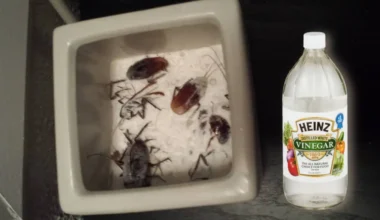If you’re fed up with unexpected encounters of roaches invading your living space, you can apply borax to kill roaches. Borax is a powdery white substance, also known as sodium borate, sodium tetraborate, or disodium tetraborate.¹ It contains insecticidal properties against roaches, and its application is a breeze. We have set up the proper steps for you to follow and apply borax effectively to reclaim your home from roach infestations.
How to apply borax to kill roaches

1. Identify roach hideouts
The first step is to identify where roaches are nesting. Roaches are omnivorous and drawn to dim and damp areas.² Thoroughly examine regions encompassing your floor’s baseboards, areas beneath or near pipes, spots with accumulated food waste, concealed spaces behind electrical outlet covers, and confined, hard-to-access areas—these areas provide ideal conditions for potential infestations.
Furthermore, if they are not viviparous or oviparous, roaches typically lay their eggs within obscure crevices.
You can elicit an escape response for roaches using a portable fan to create airflow. Alternatively, use a powerful and sudden light source. However, do not leave bait without any pesticide, this will only encourage further infestation.
2. Clear the roach nests
Roaches are likely to nest, feed, or lay eggs in areas that typically involve frequent food contact, and water exposure, or are characterized by darkness and is hard to reach. Target these areas even in the absence of visible infestation. Boric acid can have a potent preventive impact and get rid of generations of cockroaches over time.
Thoroughly examine areas where roaches may reside for any unpleasant odors. Cockroaches have various scent glands they use for communication and courtship.³ The result is distinct smells that range from sweet to oily and musky. These distinct odors serve as clear indicators of infested areas that require targeted attention.
Some roach species are even skilled at perching and can survive on elevated surfaces such as your shelves. So, make sure to perform a comprehensive inventory of these areas. Have them cleared before introducing borax to kill roaches.
3. Remove any debris from the hideout
Before you apply borax to kill roaches, ensure that the areas are free from any food debris or stagnant water. When you remove these elements, roaches will no longer have access to their primary survival resources.
Clean surfaces and eliminated standing water discourage the accumulation of resources for these critters. With borax, bait is unnecessary, and without a food source, the likelihood of spreading cockroach eggs decreases. Meanwhile, although roaches will survive without food for one month, they can only survive a week without water.
4. Prepare borax for application
If you are not comfortable making boric acid, use borax as an alternative to get rid of cockroaches. Boric acid is a stronger insecticide compared to borax and has better solubility in water, but both substances are equally safe for humans and unlikely to cause lasting harm. Both can be also applied in powdered form following the same methods for eliminating roaches. Boric acid is low in ocular toxicity.⁴
5. Create borax poison for roaches
To create boric acid and saltwater, mix excess hydrochloric acid (muriatic acid) with Borax. The resulting mixture will contain large white crystals of boric acid suspended in it. Alternatively, you can use boric acid directly, which is a less hazardous substance compared to hydrochloric acid. Hydrochloric acid is required to convert borax into the more potent insecticide, boric acid.
Be careful when handling hydrochloric acid. Protect yourself by wearing gloves, eye protection, and respiratory protection when using it, especially in a well-ventilated area—it can cause significant harm.
You’ll also need baking soda to neutralize any unintended strong acid reactions. Meanwhile, don’t use water to treat strong acid burns.
Filter the boric acid crystals to separate them from the solution. As mentioned earlier, you can neutralize any remaining strong acid in the solution by adding baking soda. The solution must be fully neutralized before disposing of it down the sink or drain to get rid of roaches. You can use litmus paper to test the acidity of the solution. Once the crystals are dry, you can store them.
6. Transfer the roach solution into a moisture-free container
Ensure that the container is clearly labeled and securely sealed for safety reasons and to prevent accidental ingestion. That’s because the product closely resembles table salt. Keep it dry to prevent the formation of large clumps.
You can repurpose an empty ketchup bottle as a bellow to apply borax to kill roaches with the insecticide powder. It will also be easier to apply it in narrow spaces, such as electrical outlets. For proper functionality, squeeze the bottle gently and verify that the powder is released. The hole in the repurposed bottle should be large enough for the borax crystals to pass through freely. Avoid getting any in your eyes, mouth, or nose.
Borax and boric acid are both soluble in hot water and can be dissolved and transferred into a spray bottle. When applied in this form, the dried residue of aqueous boric acid is virtually undetectable by insects and poses a low risk to humans. However, when applying it near electrical outlets, it is recommended to use it in powdered form instead.
7. Apply borax to kill roaches
You can apply the borax or boric acid by sprinkling or spraying it onto the desired areas. No need to mix it with bait since it does not repel insects under normal circumstances. Roaches themselves will track and spread the substance as a surface toxin to other insects. After covering the areas, take precautions to avoid any food preparation or dusting that could lead to accidental ingestion. Symptoms of borax ingestion include headache, fever, nausea, vomiting, and red eyes. Symptoms may appear 2 to 4 hours after ingesting Borax.⁵
Where to apply roach borax solution
Generally, you disperse the borax in a thin layer to make it less visible, as roaches may actively avoid it if it’s easily noticeable. Target these areas when applying borax to kill roaches:
1. Walls
You need to access the interior spaces in walls where roaches reside and lay eggs. This measure will require you to remove the electrical outlet covers. Dust the inside of the walls with borax using it as a powdered form. You don’t need the liquid form for your walls.
Use the ketchup bottle as bellows and repeatedly squeeze and spray the borax into the space. Finally, replace the outlet covers. Again, do not use dissolved borax for this purpose.
2. Apply a light dusting of borax to any identified areas
Your borax insecticide will spread within the colony through contact, effectively eliminating any roach infestation. While complete coverage is preferable, even if specific areas are targeted, the insecticide will still spread to and kill other hiding cockroaches. Roaches will typically hide in areas such as:
- Kitchen cabinets
- cupboards
- Book storage
- Electronic appliances
- Wall voids and cracks
- Bathroom areas
- Basements and crawl spaces
- Furniture
- Attics
- Drains and sewage
- Cardboard boxes and clutter
- Electrical outlets and switches
3. Apply a dry sprinkling of borax or boric acid onto carpets or rugs
Apply borax or boric acid to your carpet and rugs to eliminate any eggs and larvae present in the carpet. After approximately 20 minutes, vacuum up the powder, ensuring that any eggs or insects that were killed are removed along with it. Make sure you follow the specific care instructions for the rug.
For carpeted areas that have been treated, vacuum shortly after application to quickly exterminate any eggs. Do note that the insecticide dust can cause lung irritation or toxicity in pets and small children. Therefore, avoid leaving it in an area where it can be continuously kicked up so it doesn’t result in airborne dust.
Ultimately, before you apply borax to kill roaches in any treated areas, wipe them down with a damp cloth. If roaches persist after several days, reapply the treatment. This homemade insecticide may work gradually, but it is highly effective. Keep up with the treatment following until the roaches are completely gone.
- What is Borax? WebMD
- Cockroaches: Unwanted home invaders. University of Nebraska–Lincoln
- Rapid evolution of an adaptive taste polymorphism disrupts courtship behavior. PubMed Central
- Boric Acid: Fact Technical Sheet. NPIC
- Borax and boric acid. NSW Food Authority
Read also: tips to rid your garbage can of roaches






